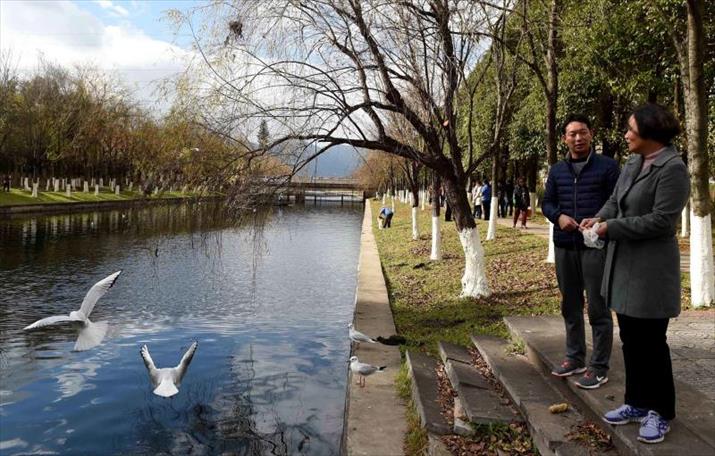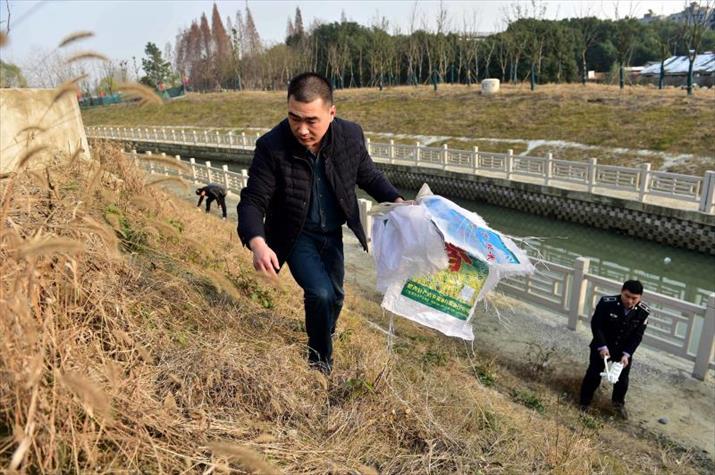|
||||||
|
||||||
| Home Nation World Business Opinion Lifestyle Multimedia Documents Special Reports Africa Travel |
|
||||||
|
||||||
| Home Nation World Business Opinion Lifestyle Multimedia Documents Special Reports Africa Travel |
| Nation |
| Making Waves |
| Cities begin to hire chiefs to protect rivers and lakes from pollution |
| By Yin Pumin | NO. 10 MARCH 9, 2017 |
 Yang Feng, a river chief in Xinhe Community in Kunming, Yunnan Province, consults a local resident on pollution control efforts on January 6 (XINHUA)
In addition to his work as chief of the Communist Party of China (CPC) committee of Yixing, a city in Jiangsu Province in east China, Wang Zhongsu was given an extra task. He was also appointed chief of the Caoqiao, a major river running into freshwater Taihu Lake. It was 2011 and at that time, the 23-km-long river was the most polluted waterway in Yixing.
The concept of "river chiefs" is an administrative measure taken by the Chinese Government to address the increasingly serious problem of water pollution. These chiefs have to protect the water resources under their jurisdiction, prevent and control pollution, manage the river banks, and undertake ecological restoration. If any environmental damage occurs in the water bodies under their supervision, they will be held accountable. "Being a river chief was a challenge to me," Wang said. "I have to shoulder a heavy responsibility."  Yu Bing, chief of a 1,000-meter section of the Shiwuli River in Hefei, Anhui Province, participates in garbage cleanup along the waterway on December 9, 2016 (XINHUA)
Coordinated action During his tenure as Caoqiao River chief, Wang found the pollution was mostly caused by dumping: agricultural and other industrial discharges as well as sewage dumped by residents. Since the problem involved different departments and regions, the chief needed to coordinate their efforts to ensure close cooperation. He persisted and brought the different parties together to plan on how best to control the pollution, and was successful in implementing the measures agreed upon. Today, the average quality of the river water meets the national Class IV standard. The national surface water standards formulated in the wake of the Environmental Protection Law and Law of Water Pollution Prevention and Control have five categories. Class IV is mainly intended for water for industrial use and entertainment which does not come in direct contact with human bodies. The useful administrative measure was initiated as early as in 2007 when a blue algae outbreak occurred in Taihu Lake. Wuxi, where the lake lies, issued a document on combating river and lake pollution and started appointing river chiefs. In 2008, the practice was expanded to all the cities and counties around the lake, and 15 provincial-level officials were appointed as river chiefs to look after the 15 rivers flowing into the lake. Presently, the river chief system has been adopted across Jiangsu, covering over 700 major rivers. Now the Central Government has decided to implement the system countrywide. In December 2016, the general offices of the CPC Central Committee and the State Council, China's cabinet, issued a document, stating that local government leaders would be responsible for managing and protecting designated waterways. One of the heads of a provincial-level region, either the Party chief or governor, will be appointed as general chief responsible for all rivers and lakes in the region, while other top officials at provincial, city, county and township levels will be river chiefs responsible for different parts of the water bodies. For large rivers and lakes spanning across regions, river chiefs will be responsible for different parts of the water bodies and cooperate in management. Their names and responsibilities will be made public to ensure public supervision. The practice is expected to be implemented nationwide by the end of 2018, the document says. Zhang Bo, Director of the Department of Water Environment Management at the Ministry of Environmental Protection, thinks the appointments will help find a balance between economic development and environmental protection. "The biggest challenge we meet in water pollution prevention and control is the unbalanced industrial structure in some regions. Many local governments are facing a choice of developing the economy or protecting the environment," Zhang said at a press conference in December 2016. "The river chief system holds top local officials accountable. This will make the adjustment of the industrial structure much easier." Following the Central Government's decision, some provinces and municipalities like Beijing, Shanghai and Hubei have started appointing river chiefs. On February 6, the Shanghai Municipal Government released a list of local government officials who have been appointed river chiefs. While Mayor Ying Yong has been appointed general river chief for the entire municipality, river chiefs and their deputies have been named for 16 districts. The municipal government said it would appoint chiefs for all rivers and lakes in Shanghai by the end of the year. According to the Shanghai Environmental Protection Bureau, there are over 630 km of polluted rivers in Shanghai, mainly in suburban districts. The bureau has set a goal of cleaning up all rivers and lakes by the end of this year. By 2020, the water quality of 78 percent of major rivers and lakes will meet national standards. The Beijing Municipal Government will clear 665 km of polluted river stretches by this year and have chiefs for all rivers and lakes in the city by 2018. Hubei's over 1,200 rivers and 700 lakes will have chiefs by the end of the year. In Shaanxi Province in northwest China, the provincial government has pledged to invest 17.77 billion yuan ($2.58 billion) in its water pollution control campaign, which will include appointing river chiefs. The concept is being promoted among the public in various ways. Hangzhou in Zhejiang Province has come up with innovative means. Its water bureau has compiled a handbook on the river chief system for residents to understand the work of these officials. Also, a mobile app provides information on the more than 1,800 rivers in Hangzhou, and people can directly contact the river chiefs if they want to report cases of pollution. The city authorities are also using social media platforms, such as QQ and WeChat, for this. Accountability In addition, measures are being taken to hold the river chiefs accountable. Jiangsu has a history of pulling up the river chiefs who were perceived as failing in their duty. In Wuxi's Huishan District, each river chief has to put up a 3,000-yuan ($-436) deposit at the beginning of the year. There is an evaluation at the end of the year, and those who have improved the quality of the water bodies in their jurisdiction get their deposits back along with a bonus. Those who have maintained the status quo get the deposit back sans bonus, and those who have seen the water bodies under their management deteriorate forfeit the deposit. In Guangzhou in south China's Guangdong Province, a points system has been adopted. River chiefs' in-office behavior is monitored, and negative actions, such as refusing to accept telephone calls, laziness or giving out false information, result in the chiefs losing their brownie points. At the end of every year, those with less than 60 points will be pulled up. Copyedited by Sudeshna Sarkar Comments to yinpumin@bjreview.com |
About Us | Contact Us | Advertise with Us | Subscribe
|
||
| Copyright Beijing Review All rights reserved 京ICP备08005356号 京公网安备110102005860号 |